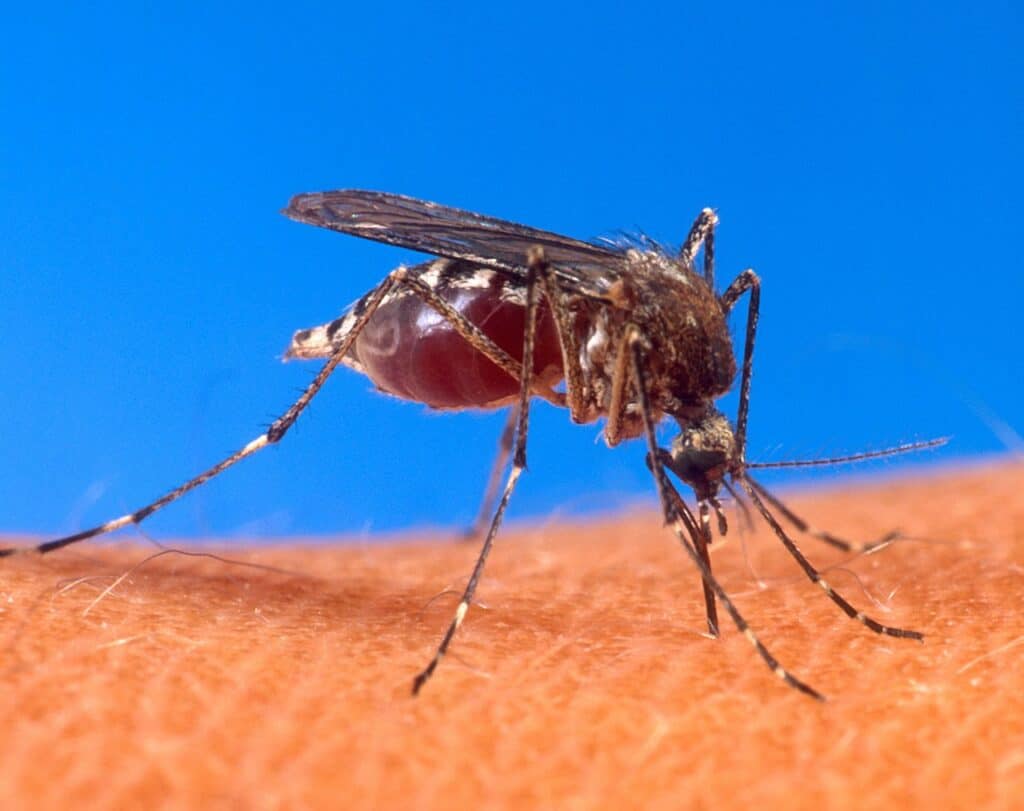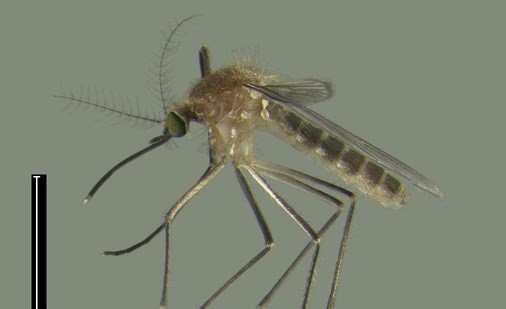They may be annoying, but they’re a crucial part of the natural world.
Peterborough Examiner – May 19, 2023 – by Drew Monkman
Every year when mid-May rolls around, the relative number of mosquitoes becomes a popular topic of conversation – and one not always appropriate for tender ears. If my recent yardwork and birding outings are any indication, they already seem particularly abundant. I have the bites to prove it.
But we shouldn’t focus our perception entirely on the itchy welts they leave. Mosquitoes play a central role in many ecosystems and can be thought of as an energy pipeline. The larvae convert decomposing plant matter into living insect protein, fat and carbohydrates. They therefore serve as food for countless other animal species including fish. Adult mosquitoes are preyed upon by everything from barn swallows to little brown bats, both of which are declining dramatically.
Since 1913, we’ve also known that mosquitoes play a role in pollination. Pollen will sometimes stick to their legs and be moved inadvertently from one flower to the next. As just one example, the woodland snow pool mosquito (Aedes communis)is an important pollinator of blunt-leaf orchids, a species found in many parts of Peterborough County. When people spray or destroy mosquito habitat, the energy pipeline and pollinator services are shattered, and myriad species suffer.
Their famous “bite”
Even the most hardened conservationist will agree that mosquitoes are aggravating. Their irritating buzz – 500 wing beats per second – can make it nearly impossible to fall asleep at night. It’s their “bite”, however, that’s most bothersome. But mosquitoes don’t actually bite you; they stab you with their proboscis. As for the itch, it’s caused by their saliva. Mosquito saliva contains an anti-coagulant that allows blood to be sucked up more easily. It also precipitates a histamine response in our bodies which causes the itch, the bump and the redness.
Things could be much worse, however. Only female mosquitoes give you the jab and it’s not because they’re hungry. The mosquito that lands on your body is pregnant and needs protein from your blood for the eggs in her body to develop properly. A single blood meal enables the female to lay hundreds of healthy, protein-rich eggs. The main food source for both sexes is actually nectar and other sugary fluids from plants.
Some local species
The Kawarthas is home to 25 or more kinds of mosquitoes. Some do not bite humans at all, limiting their blood consumption to a wide range of other animals including frogs. Many of the mosquitoes found here belong to the genus Aedes and go through a typical mosquito life cycle. The larvae hatch from hardy “rafts” of eggs laid the previous year in mud or on standing water. In the spring, muddy areas are flooded by melting snow and rainfall which creates an ideal habitat for the larvae to develop. They progress through several stages of larval growth before transforming into a pupa. Adults emerge from the pupa.
Only a day or so after emergence, they are ready to procreate. After mating, the females begin to seek a blood meal. Some Aedes species breed only once while others, such as the inland floodwater mosquito (Aedes vexans) breed continuously from June until September. Vexans is usually only a problem in wet summers, however, because it requires muddy areas in which to lay its eggs. For this species, the period from the time the eggs are laid until the adults emerge can be as little as four to five days under favorable conditions.
One mosquito species that gets a lot of bad press because of its link to disease transmission is the northern house mosquito (Culex pipiens). Small or medium in size, the house mosquito has a brown or yellowish coloration and distinctive abdominal bands. It thrives in urban areas and is present from spring until fall. The female lays her eggs in locations where water collects and stands still. This can include anything from flowerpots to discarded coffee cups. The eggs develop into adults in about a week to 10 days.
Unlike Aedes mosquitoes which survive the winter as eggs, the house mosquito overwinters as adult, pregnant females. They find shelter in locations where the temperature remains above freezing, such as sewers, well pits, the basements of houses, and even animal burrows. With warm spring days, these females seek a blood meal and begin the cycle again. Interestingly enough, their flight range is quite small. The mosquito that bit you in the driveway may well have hatched in the backyard.
Disease transmission
Culex mosquitoes like the northern house are the primary suspect for transmission of West Nile virus to humans. Mosquitoes testing positive for the virus were trapped in Peterborough last summer. A mosquito becomes infected when it feeds on the blood of a bird that carries the virus. Although the risk of getting West Nile disease from a mosquito bite is very low, the health effects can be serious.
In addition to the threat posed by West Nile virus, there is also concern about how climate change will affect mosquito populations and their ability to spread diseases such as malaria and possibly even dengue fever, Zika and chikungunya. Mosquito species capable of spreading malaria already exist in Canada. In a 2019 study published by the Public Health Agency of Canada, V. Ng and fellow researchers concluded that, with climate change, “New mosquito species may move into Canada from other countries, and these exotic species may bring exotic mosquito-borne diseases as well.”
Now, according to recent modelling done by BlueDot, a Canadian software company that maps the spread of infectious diseases, cities like Toronto could soon become host to Asian tiger mosquitoes (Aedes albopictus). They can carry the virus that causes both dengue fever and Zika.
Protecting yourself
Mosquitoes lack good vision. They locate you by relying on the carbon dioxide you exhale. They can smell their victim from an impressive 36 metres away. They are also drawn to movement, body heat and even to the lactic acid from your sweat glands. People with type O blood – the most common blood type – seem to be bit the most.
To avoid getting bitten, consider using personal insect repellents that contain either DEET or picardin. DEET actually has an excellent safety record. In a study published in the New England Journal of Medicine in 2002, researchers found that “OFF! Deep Woods” repellent fared the best. Its protection lasted an average of five hours. According to the American Academy of Pediatrics, DEET is also safe for children aged two months and older – even up to 30% concentration.
Apply the repellent only on exposed skin surfaces or on top of clothing. Sunscreen and personal insect repellents can be used safely at the same time but be sure to apply the sunscreen first. It’s also important to cover up as much as possible. Keep in mind, too, that that wearing colours like red, orange, and black attracts mosquitoes to your body.
Given both the nuisance factor and the threat of disease that mosquitoes represent, it’s understandable that some people hire a mosquito-control company to spray their yard with insecticide. Forget what their marketing claims might say. These poisons don’t just harm mosquitoes. They are also highly toxic to native pollinators such as bees and butterflies, fish, and even pets and people. We shouldn’t sacrifice native wildlife and put our own health at risk when there are much safer ways to keep them away.
CLIMATE CRISIS UPDATE
Carbon Dioxide: Atmospheric CO2 readings for the week ending May 13 registered 424.29 parts per million (ppm) compared to 420.75 ppm one year ago. Human activities have raised atmospheric CO2 by 50% since the Industrial Revolution. In other words, the amount of CO2 in the atmosphere – the main cause of climate change – is now 150% of its value in 1750. Rising CO2 means more global heating ahead and therefore more extreme weather and wildfires like those devastating many parts of Alberta right now.
4RG Meets: On May 9, Dr. Anne Pasek of Trent University was the speaker at 4RG Meets. Each meet features a local expert on a topic related to the climate crisis. Anne explored how climate opinion and engagement in climate action varies across communities, based on race, gender, class, age, partisan affiliations, geography, and religion. She also outlined the strategic value of diversifying the climate movement. You can watch a recording of her presentation at https://tinyurl.com/yc3keazr

